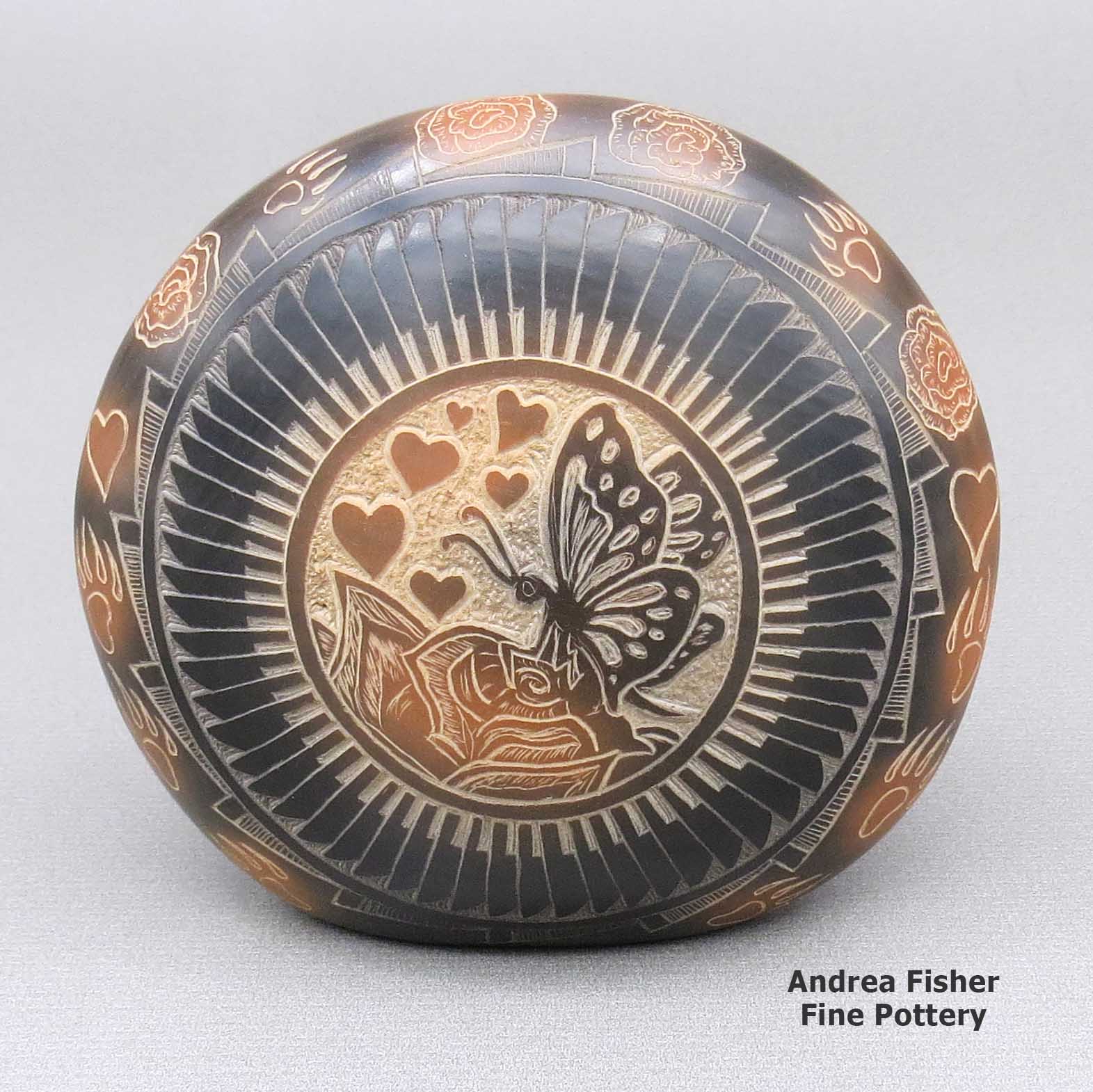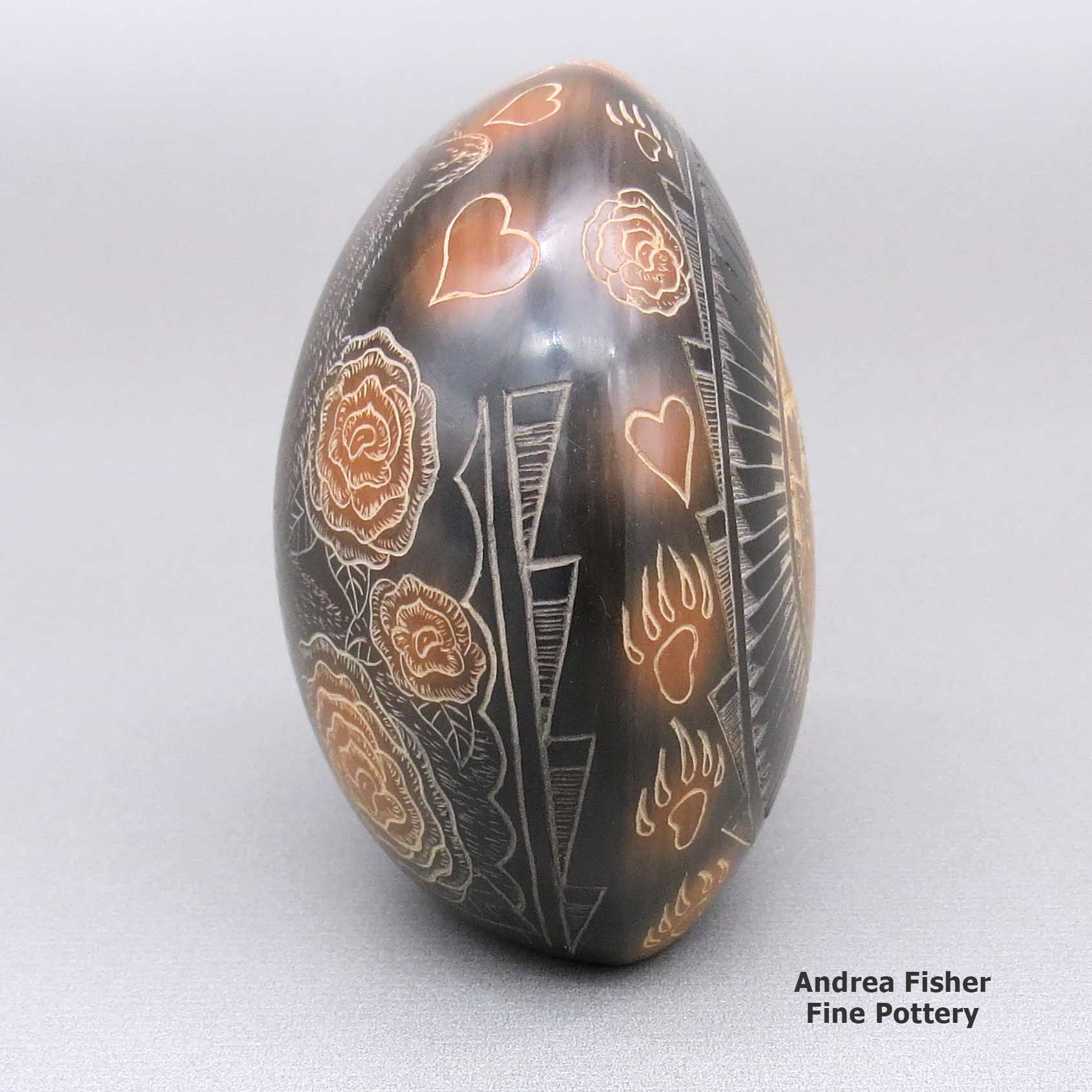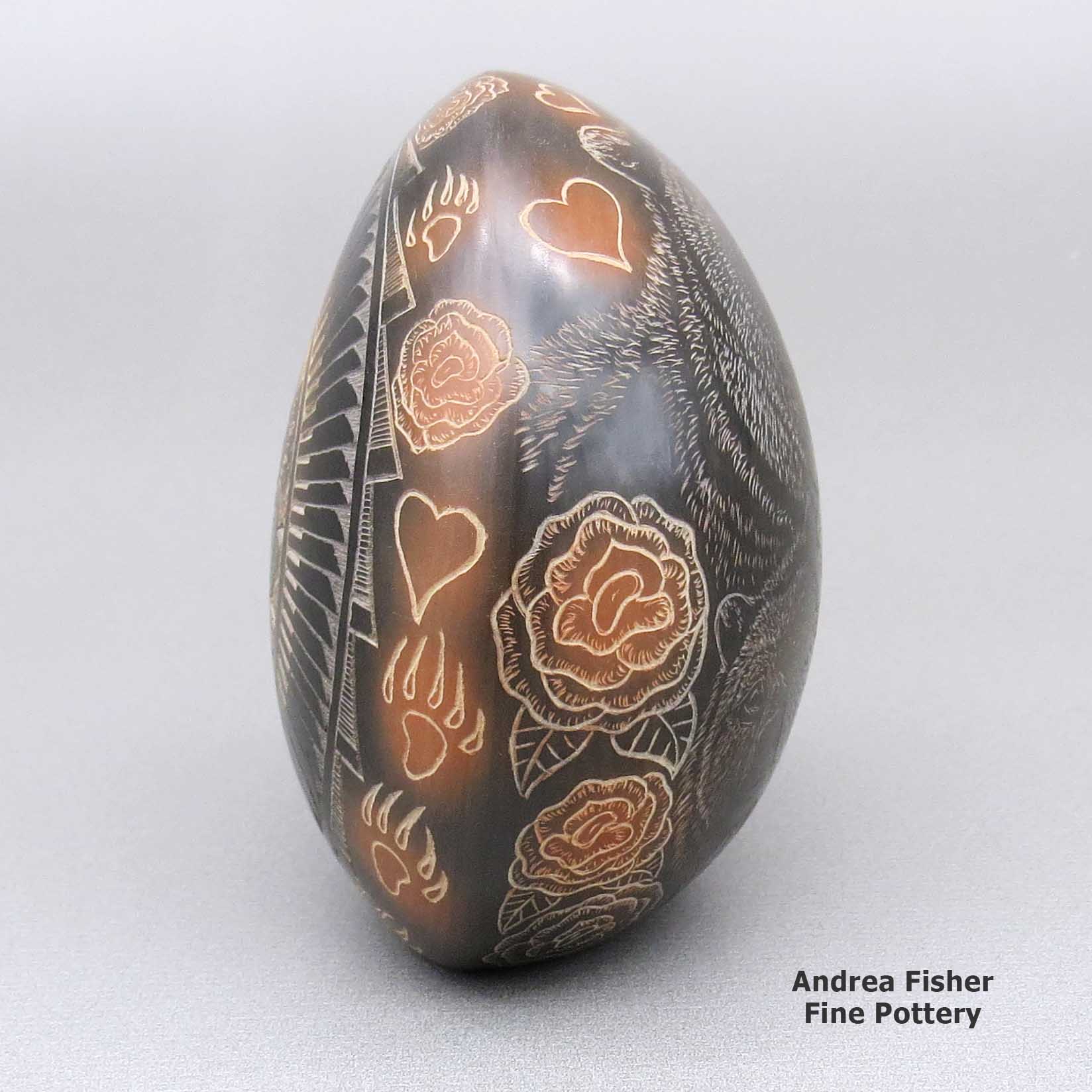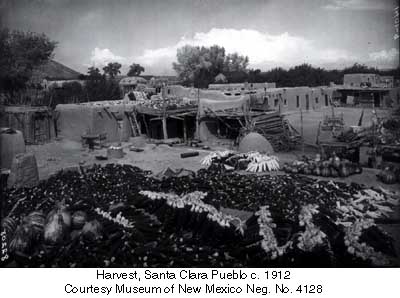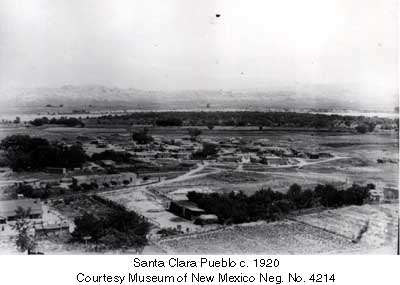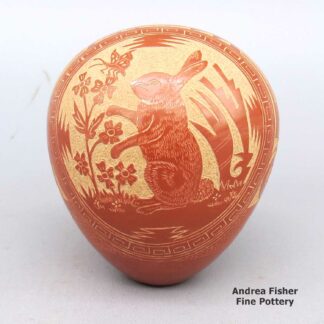| Dimensions | 1.75 × 3 × 3 in |
|---|---|
| Condition of Piece | Excellent |
| Signature | Kevin Naranjo SCP |
| Date Born | 2023 |
Kevin Naranjo, zzsc3b032, Seed pot with heart, wildlife and geometric design
$725.00
A black seed pot decorated with sienna spots and a sgraffito bear, butterfly, flower, bear paw, heart, feather ring and geometric design
In stock
Brand
Naranjo, Kevin
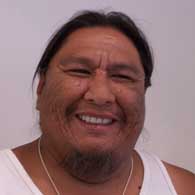 Born in 1972 at Santa Clara Pueblo, Kevin Naranjo was given a Tewa name meaning Turquoise Mountain. He says he was inspired to learn the ancient tradition of hand coiling pottery by the time he was four. That inspiration came from his family and his love of nature.
Born in 1972 at Santa Clara Pueblo, Kevin Naranjo was given a Tewa name meaning Turquoise Mountain. He says he was inspired to learn the ancient tradition of hand coiling pottery by the time he was four. That inspiration came from his family and his love of nature.Kevin was born into a family of famous potters, including Luther Gutierrez (his great-grandfather), Dolores Curran (a maternal aunt) and Geri Naranjo (his mother). Geri is renowned for her miniature sgraffito (fine line incised) pottery, the traditional methods of which she taught to both Kevin and his sister, Monica Naranjo.
Specializing in hand coiled black and sienna sgraffito pottery, Kevin gathers his clay from sacred grounds within Santa Clara Pueblo. He digs and prepares the clay, hand-coils and shapes his forms, then lets them dry for a few days. Then he stone polishes the surfaces and ground fires his pottery using an oxygen-reduction process to make the black canvas for his designs. After firing, he etches the pot to create wonderful scenes of wildlife that live in the area of his home at Santa Clara.
The first piece he made as a child was a dinosaur. He remembers it well: it sparked an interest in molding animal figurines. That first inspiration and practice evolved until now his pottery embodies beautiful symmetry, graceful lines and finely executed sgraffito designs like the avanyu (water serpent), kiva steps and the feather pattern. Additional figures such as bears, eagles, bighorn sheep, deer and elk are incorporated into backgrounds of pueblo ruins and mountain views.
For several years, Kevin collaborated with Tricia Pena from San Ildefonso Pueblo. Her grandfather, the late Encarnacion Pena, was a member of the original San Ildefonso School of Painters.
Kevin has consistently earned awards for his sgraffito and miniature pottery since starting to compete in 1994. He's most proud of the First Place and Best of Division ribbons he earned in the Miniature Sgraffito category at the 2004 Santa Fe Indian Market. He'd earned his first First Place ribbon at the 2000 Santa Fe Indian Market with a burnished black Miniature Sgraffito piece.
A Short History of Santa Clara Pueblo

Santa Clara Pueblo straddles the Rio Grande about 25 miles north of Santa Fe. Of all the pueblos, Santa Clara has the largest number of potters.
The ancestral roots of the Santa Clara people have been traced to ancient pueblos in the Mesa Verde region in southwestern Colorado. When the weather in that area began to get dry between about 1100 and 1300 CE, some of the people migrated to the Chama River Valley and constructed Poshuouinge (about 3 miles south of what is now Abiquiu on the edge of the mesa above the Chama River). Eventually reaching two and three stories high with up to 700 rooms on the ground floor, Poshuouinge was inhabited from about 1375 CE to about 1475 CE.
Drought then again forced the people to move. One group of the people went to the area of Puyé (along Santa Clara Canyon, cut into the eastern slopes of the Pajarito Plateau of the Jemez Mountains). Another group went south of there to what we now call Tsankawi. A third group went a bit to the north, following the Rio Chama down to where it met the Rio Grande and founded Ohkay Owingeh on the northwest side of that confluence.
Beginning around 1580, another drought forced the residents of the Puyé area to relocate closer to the Rio Grande. There, near the point where Santa Clara Creek merged into the Rio Grande, they founded what we now know as Santa Clara Pueblo. Ohkay Owingeh was to the north on the other side of the Rio Chama. That same dry spell forced the people down the hill from Tsankawi to the Rio Grande where they founded San Ildefonso Pueblo to the south of Santa Clara, on the other side of Black Mesa.
In 1598 Spanish colonists from nearby Yunqué (the seat of Spanish government near the renamed "San Juan de los Caballeros" Pueblo) brought the first missionaries to Santa Clara. That led to the first mission church being built around 1622. However, the Santa Clarans chafed under the weight of Spanish rule like the other pueblos did and were in the forefront of the Pueblo Revolt of 1680. One pueblo resident, a mixed black and Tewa man named Domingo Naranjo, was one of the rebellion's ringleaders.
When Don Diego de Vargas came back to the area in 1694, he found most of the Santa Clarans were set up on top of nearby Black Mesa (with the people of San Ildefonso, Pojoaque, Tesuque and Nambé). An extended siege didn't subdue them but eventually, the two sides negotiated a treaty and the people returned to their pueblos. However, successive invasions and occupations by northern Europeans took their toll on the pueblos over the next 250 years. The Spanish flu pandemic in 1918 almost wiped them out.
Today, Santa Clara Pueblo is home to as many as 2,600 people and they comprise probably the largest per capita number of artists of any North American tribe (estimates of the number of potters run as high as 1-in-4 residents).
For more info:Pueblos of the Rio Grande, Daniel Gibson, ISBN-13:978-1-887896-26-9, Rio Nuevo Publishers, 2001
Upper photo courtesy of Einar Kvaran, Creative Commons Attribution-Share Alike 3.0 Unported License
About the Seed Pot
It was a matter of survival to the ancient Native American people that seeds be stored properly until the next planting season. Small, hollow pots were made to ensure that the precious seeds would be kept safe from moisture, light, bugs, reptiles and rodents.
After seeds were put into the pot, the small hole in the pot was plugged. The following spring the plug was removed and the seeds were shaken from the pot directly onto the planting area.
Today, seed pots are no longer necessary due to readily available seeds from commercial suppliers. However, seed pots continue to be made as beautiful, decorative works of art.
The sizes and shapes of seed pots have evolved and vary greatly, depending on the vision of Clay Mother as developed through the artist. The decorations vary, too, from undecorated white, buff or red seed pots to multi-colored painted, carved, applique and sgraffito designs, sometimes with inlaid gemstones, micaceous clay and silver or clay lids.
Because of the multitude of shapes and sizes, the name "seed pot" is generally reserved for pieces with tiny openings.
About Wildlife and Nature Designs
What we're calling "wildlife and nature designs" are usually quite contemporary designs carved, painted and/or etched by hand on a hand-made piece of pottery. In the same genre are bird, butterfly, dragonfly, moth, bat and fish designs. Some have seaweed and vines, some have trunks and branches, some have leaves and/or flowers and/or berries, some don't. Some are composed of optical illusions while others are very clear to the eye. While the designs and layouts tend to be quite contemporary, sometimes they incorporate elements of ancient settings.
Marie Suazo Family Tree - Santa Clara Pueblo
Disclaimer: This "family tree" is a best effort on our part to determine who the potters are in this family and arrange them in a generational order. The general information available is questionable so we have tried to show each of these diagrams to living members of each family to get their input and approval, too. This diagram is subject to change should we get better info.
- Marie Suazo
- Ursulita Naranjo and Alfred Naranjo
- Dolores Curran & Alvin Curran (San Juan) (1953-1999)
- Geri Naranjo
- Kevin Naranjo (1972-)
- Monica Naranjo (Romero)
- Alfred Ervin Naranjo & Jennifer Naranjo (Sisneros)
- Alfred Naranjo (1980-)
- Dolores Curran & Alvin Curran (San Juan) (1953-1999)
